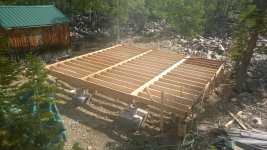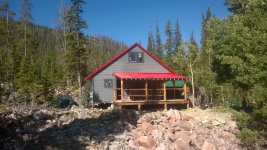quicksandfarmer
Elite Member
Some thoughts:
You will never regret having a building well-insulated. Even if you only use it seasonally, the ability to be comfortable at the edges of the season is something you will appreciate. Even if it's unheated, if it's tight you can close it up and stay reasonably comfortable with just the heat from your activity in cool weather. The nature of these kinds of places is either you use them a lot less than you expected, or a lot more. If it ends up being a lot more you'll find yourself going there in all kinds of weather.
Keeping rodents out is always a concern and particularly with seasonal-use buildings. Even if you can't keep them completely out you want to limit the amount of harborage you give them. So everything should be as tight as possible. A mouse can go through a hole the size of a dime, a rat through a hole the size of a quarter. So I like the idea of boxing the bottoms of the floor joists with plywood. Since by the look of the pictures it doesn't seem like you have much clearance below, I like the idea of running cleats along the joists and doing all of the work from above. But I see some issues. Whenever you insulate you have to worry about moisture. If any gets in there it's not going to have a way out. There is a constant debate about whether it is better to seal things up completely and keep moisture out, or give it a way out. I would consider using 7/16" Zip board for the bottom, it's about the same price as 1/4" CDX plywood around here, but has better weather resistance. It also is less likely to warp so it will stay tight. If you decide you want moisture to have a way out you might put a round vent at each end of each bay.
A lot of people around here are using wood I-beams for joists, if you used them the cleats would be built in. I don't know how they compare price wise.
It's going to be really important to keep the insulation dry until the building is sealed. It's going to be a challenge though and it may be your biggest issue. The idea of building the sub-floor so it can be removed is intriguing, but I think having a solid subfloor gives a better building. If nothing else you have a solid barrier against rodents.
Roxul insulation has better moisture resistance than fiberglass, but is somewhat more expensive. This might be a good use for it.
What about plumbing and electrical? Are you going to have those? With the joist bays sealed it's going to be very hard to run those.
I would do it so that if you had to, you could come in from below later and get into the joist bays. If the plywood isn't fastened to the cleats, I think with 2x8 or larger joists you could lift the plywood from below and angle it and pull it out. You could also just pick up a piece and slide it over a neighboring piece. Think of like a suspended ceiling.
It may end up being easiest to put the sheets of plywood in while you're framing, but not the insulation. Once the building is sealed, crawl under, slide the plywood to one end, put up the insulation and slide the boards back. It depends a lot on how much clearance you have.
You will never regret having a building well-insulated. Even if you only use it seasonally, the ability to be comfortable at the edges of the season is something you will appreciate. Even if it's unheated, if it's tight you can close it up and stay reasonably comfortable with just the heat from your activity in cool weather. The nature of these kinds of places is either you use them a lot less than you expected, or a lot more. If it ends up being a lot more you'll find yourself going there in all kinds of weather.
Keeping rodents out is always a concern and particularly with seasonal-use buildings. Even if you can't keep them completely out you want to limit the amount of harborage you give them. So everything should be as tight as possible. A mouse can go through a hole the size of a dime, a rat through a hole the size of a quarter. So I like the idea of boxing the bottoms of the floor joists with plywood. Since by the look of the pictures it doesn't seem like you have much clearance below, I like the idea of running cleats along the joists and doing all of the work from above. But I see some issues. Whenever you insulate you have to worry about moisture. If any gets in there it's not going to have a way out. There is a constant debate about whether it is better to seal things up completely and keep moisture out, or give it a way out. I would consider using 7/16" Zip board for the bottom, it's about the same price as 1/4" CDX plywood around here, but has better weather resistance. It also is less likely to warp so it will stay tight. If you decide you want moisture to have a way out you might put a round vent at each end of each bay.
A lot of people around here are using wood I-beams for joists, if you used them the cleats would be built in. I don't know how they compare price wise.
It's going to be really important to keep the insulation dry until the building is sealed. It's going to be a challenge though and it may be your biggest issue. The idea of building the sub-floor so it can be removed is intriguing, but I think having a solid subfloor gives a better building. If nothing else you have a solid barrier against rodents.
Roxul insulation has better moisture resistance than fiberglass, but is somewhat more expensive. This might be a good use for it.
What about plumbing and electrical? Are you going to have those? With the joist bays sealed it's going to be very hard to run those.
I would do it so that if you had to, you could come in from below later and get into the joist bays. If the plywood isn't fastened to the cleats, I think with 2x8 or larger joists you could lift the plywood from below and angle it and pull it out. You could also just pick up a piece and slide it over a neighboring piece. Think of like a suspended ceiling.
It may end up being easiest to put the sheets of plywood in while you're framing, but not the insulation. Once the building is sealed, crawl under, slide the plywood to one end, put up the insulation and slide the boards back. It depends a lot on how much clearance you have.


